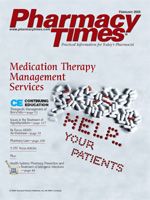Publication
Article
Pharmacy Times
CASE STUDIES
Author(s):
CASE 1: SP, a 33-year-old male, is admitted to the hospital on Fridayevening with asthmatic bronchospasm. He is well known to the hospitalstaff for frequent hospitalizations due to uncontrolled asthma.The on-call medical resident initiates SP on an aminophyllineinfusion. The infusion is started at a rate of 20 mg/hr. Before the residentheads off to the on-call room to catch a few hours of rest, heorders a theophylline level for the morning.
The theophylline level is drawn at 6 AM, less than 12 hours afterthe aminophylline infusion was started. When the resident returns tocheck on SP, he calls the laboratory to obtain the results of the theophyllinelevel. He is informed that the level is only 6 mg/L. The residentwould like the level to be 12 mg/L (twice the current level), sohe doubles the rate of the aminophylline infusion.
Monday morning, the clinical pharmacist returns from her weekendoff. As she enters her office, she receives a phone call from thenurse taking care of SP. The nurse explains that SP is complainingof nausea, a racing heart, and nervousness. She is concerned thatone of his medications may be causing these symptoms and wouldlike the pharmacist to review his medication profile.
When the clinical pharmacist notices that SP's aminophylline infusionhas been running at 40 mg/hr since Saturday morning, she contactsthe resident. She recommends obtaining another aminophyllinelevel because SP's symptoms are consistent with theophylline toxicity.
The theophylline level is reported as 25 mg/L. The resident is confusedby the level, since he was convinced that the level would beclose to 12 mg/L.
Why did the level skyrocket to 25 mg/L, rather than simply doublefrom 6 mg/L to 12 mg/L?
CASE 2: NC, a 20-year-old college student, presents to the localhospital claiming to have ingested 40 acetaminophen 500-mg tablets4 hours earlier. She admits that she was trying to hurt herselfbecause her boyfriend had just dumped her. After taking the tablets,she realized that she was scared to die, particularly when she startedexperiencing nausea and vomiting, and wanted to be helped.
The physician ordered baseline electrolytes, liver function tests,complete blood count, urine drug screen, and a pregnancy test, alongwith an acetaminophen level. The acetaminophen level was reportedas 245 mcg/mL, and her liver function tests were within normal limits.The physician orders that N-acetylcysteine be initiated immediately.
When NC smells the N-acetylcysteine, she refuses to drink it. Thephysician explains that this therapy will reduce her risk of hepatotoxicity.NC says the nausea is improving (except when she smells the N-acetylcysteine),and she does not have any other symptoms of liver toxicity.
When would signs and symptoms of acute hepatic injury occur?
Dr. Schlesselman is a clinical pharmacist based in Niantic, Conn.
Click Here For The Answer ----------->
[-]
CASE ONE
The initial level was drawn before the aminophyllinereached steady state. By increasing the infusion rate,rather than waiting for steady state, the theophylline levelexceeded the therapeutic range.
CASE TWO
Most patients do not exhibit signs and symptoms ofacute hepatic injury until 1 to 3 days after overdose. Liverfunction tests would also not be abnormal this early afteringestion. To prevent hepatotoxicity, NC should initiate Nacetylcysteinetherapy as soon as possible. Due to thehorrible smell and taste of N-acetylcysteine, manypatients require placement of a nasogastric tube toadminister it.
toggle(getObject('exp1048685570_link'), 'exp1048685570');







